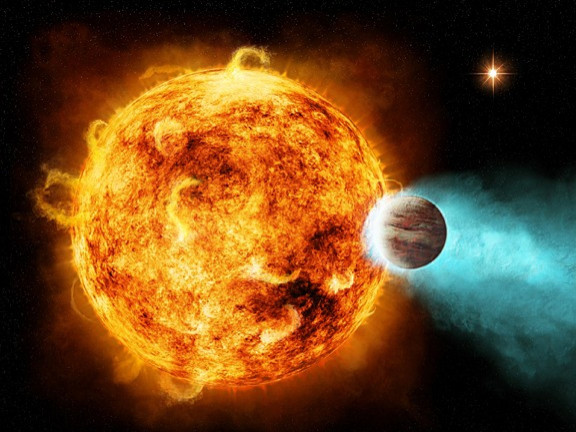Star Hammers Alien Planet With Brutal X-ray Blasts

A new study suggests that a star is attacking a nearby planet which is 880 light-years from Earth with a storm of X-rays that is hundred thousand times more powerful than what Earth receives from the Sun.
The new gas planet CoRoT-2b, is giving out 5 million tons of matter every second from the X-rays, data from NASA's Chandra X-ray Observatory and the European Southern Observatory's Very Large Telescope suggests.
The planet known as CoRoT-2b has a mass about three times that of Jupiter and 1,000 times that of Earth. The planet is also orbiting the highly active planet, CoRoT-2a, at a distance about 10 times that is between Earth and the moon.
The planet was discovered in 2008 by using the European Convection, Rotation and planetary Transits (CoRoT) satellite.
The study was published in the journal Astronomy and Astrophysics.
This planet is being absolutely fried by its star, study lead author Sebastian Schroeter, of the University of Hamburg in Germany, said in a statement. What may be even stranger is that this planet may be affecting the behavior of the star that is blasting it.
CoRoT-2 is one of the most unusual planetary systems known to date, according to the study, as the planet has an extremely active star that orbits at a very close distance to the planet.
The CoRoT-2 system is expected to be between about 100 million and 300 million years old.
Czesla said that the planet's proximity to the star may be speeding up the star's rotation, keeping its magnetic fields active. The star, which is between 100 million and 300 million years old, would likely be less volatile if not for nearness of CoRoT-2b.
The new Chandra observations suggest that the star is very active for its age with bright X-ray emission that is produced by powerful magnetic fields.
Because this planet is so close to the star, it may be speeding up the star's rotation and that could be keeping its magnetic fields active, study co-author Stefan Czesla, also from the University of Hamburg said. If it wasn't for the planet, this star might have left behind the volatility of its youth millions of years ago.
Researchers also say that the destruction to the planet will be useful because the planet is simply too big. It is believed to be a form of self-correction by some researchers that will eventually die down with time, io9.com reported.
We're not exactly sure of all the effects this type of heavy X-ray storm would have on a planet, but it could be responsible for the bloating we see in CoRot-2b, Schroeter said. We are just beginning to learn about what happens to exoplanets in these extreme environments.
© Copyright IBTimes 2024. All rights reserved.





















